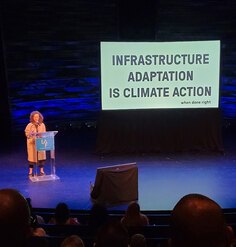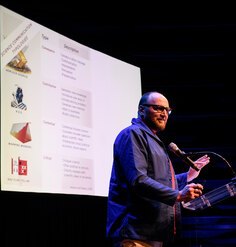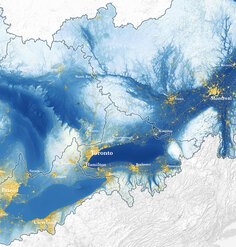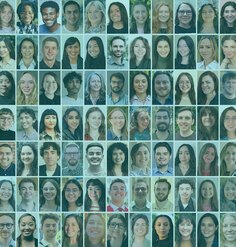LAF Fellowship Spotlight: Roadsides and Power Theory in Landscape Architecture
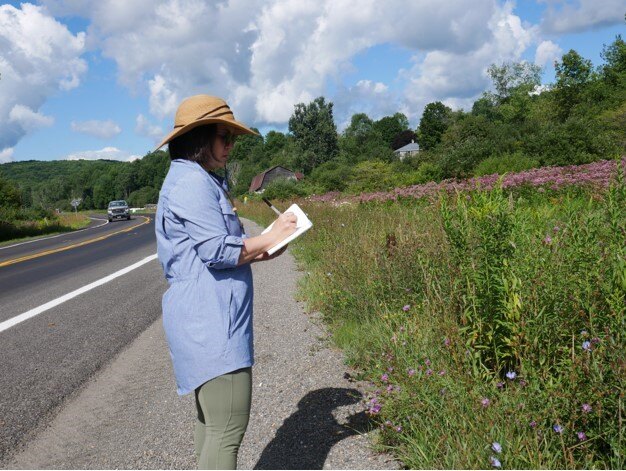
Members of the 2021-2022 cohort of the LAF Fellowship for Innovation and Leadership have spent the last 8 months exploring their big ideas and advancing their proposed projects. The Fellows will present the culmination of their work at LAF’s Innovation + Leadership Symposium in June 2022. In the meantime, LAF is profiling each Fellow to share more about their progress and personal journeys.
As a young professional, Ellen Oettinger White worked for the Brooklyn Borough President in New York City, then studied urban planning and worked as a transportation planning consultant. Though she enjoyed working on policy and transit planning, she wanted to be more involved in street design projects.
During this period, Ellen rode her bike across the U.S., spending the hours, weeks, and months immersed in expansive landscapes and feeling the land changing both incrementally and dramatically at the same time. Ellen shares, “My path through the land was not free or aimless; it was directed by these constructed landscapes, roads that are governed by a wide array of engineering standards and construction practices, some of them influenced by landscape architects.”
This experience influenced Ellen’s focus in pursuing a Master of Landscape Architecture at Rutgers. “It led to an opening of these road infrastructure and aesthetic issues that I didn’t expect. That is where I found the tools to study some of these bigger questions about the nature of infrastructural landscapes that we humans create in order to traverse land.”
Roadsides constitute millions of acres of public land nationwide, and people collectively take over a billion car trips per day through these landscapes. To some, roadsides may seem like fleeting, throwaway landscapes, but they are incredibly important and represent an enormous opportunity for multi-functional infrastructure. Landscape architects working within the transportation agencies that control these landscapes have historically exercised significant power.
Centered around state highway agencies, Ellen's LAF Fellowship project delves into the nature of power in landscape architecture — where it is derived, how it is used, and how it can perpetuate or challenge systemic inequalities. She has conducted almost 40 interviews, which have given rise to more questions that are shaping her research on power theory development.
“Landscape architects in transportation settings who felt they had a voice or an influence over what the highway engineers were doing were the ones who had a very long tenure at these public agencies. They spent decades proving their expertise to their colleagues and building relationships, while engineers were granted that assumption of expertise the moment they enter the room,” Ellen observed.
This signifies the power of character that many landscape architects have. “We derive power not only from our expertise and skills but also from the land and something more mythic and spiritual that stands up in the face of these standards governing design and construction. There is something very noble in that, even if it doesn’t always bear the results in the built environment that we want to see. I think it can.” Ellen believes things are changing and the standards that have shut out the ideas of landscape architects in the past are being brought to light and questioned more in the transportation sector as a whole.
Ellen shared the most difficult part during this research so far has been distilling so many ideas and disciplinary threads into a meaningful narrative. The topic has proven more complex than she initially surmised, and Ellen is tackling the challenge of breaking the issues down into something more digestible and transferable beyond the transportation sector. The reflection process inherent in the fellowship has forced her to step outside her comfort zone, to make adjustments by permitting more time to ruminate and process new ideas, which often felt counter-productive. This allowed room to discover insights and make connections when least expected — in the middle of the night, while reading books to her kids, or out while walking or running. She has also learned to appreciate the vastness of searching, distilling, introspection, and repetition that is required to arrive at a meaningful method for generating and conveying ideas — no matter who your audience is.
The LAF Fellowship has empowered Ellen to use this project to give a voice and bring attention to a subset of the landscape architecture profession that is often overlooked in favor of more glamorous work in the private sector. The investment of time and thoughtfulness given to the process, along with the tremendous depth of knowledge and feedback shared among the cohort and leaders has been motivating and humbling.
Ellen’s perspective on what power means has shifted to include a wider lens of the role of landscape architects and how influential they can be, even in settings that may seem dominated by other professions. Her next steps include working out the best language and method for conveying this story and tracing the genealogy of landscape architecture and road design. “What is powerful to me about landscape architects is how influential they can be in multidisciplinary settings, even when we aren’t in positions of authority.”
